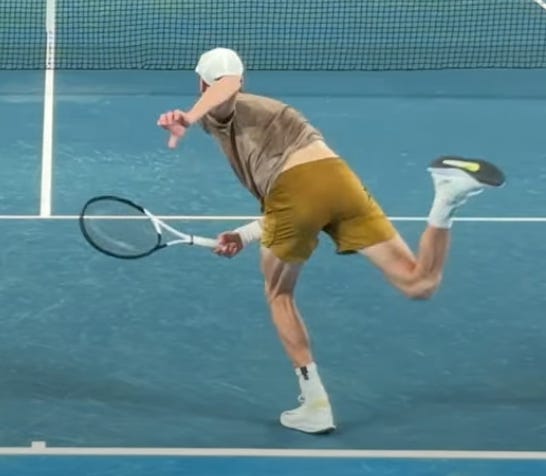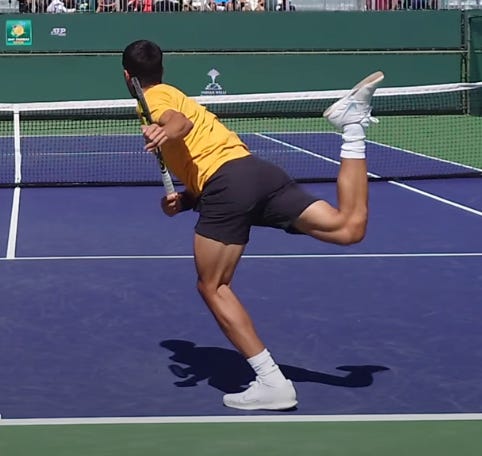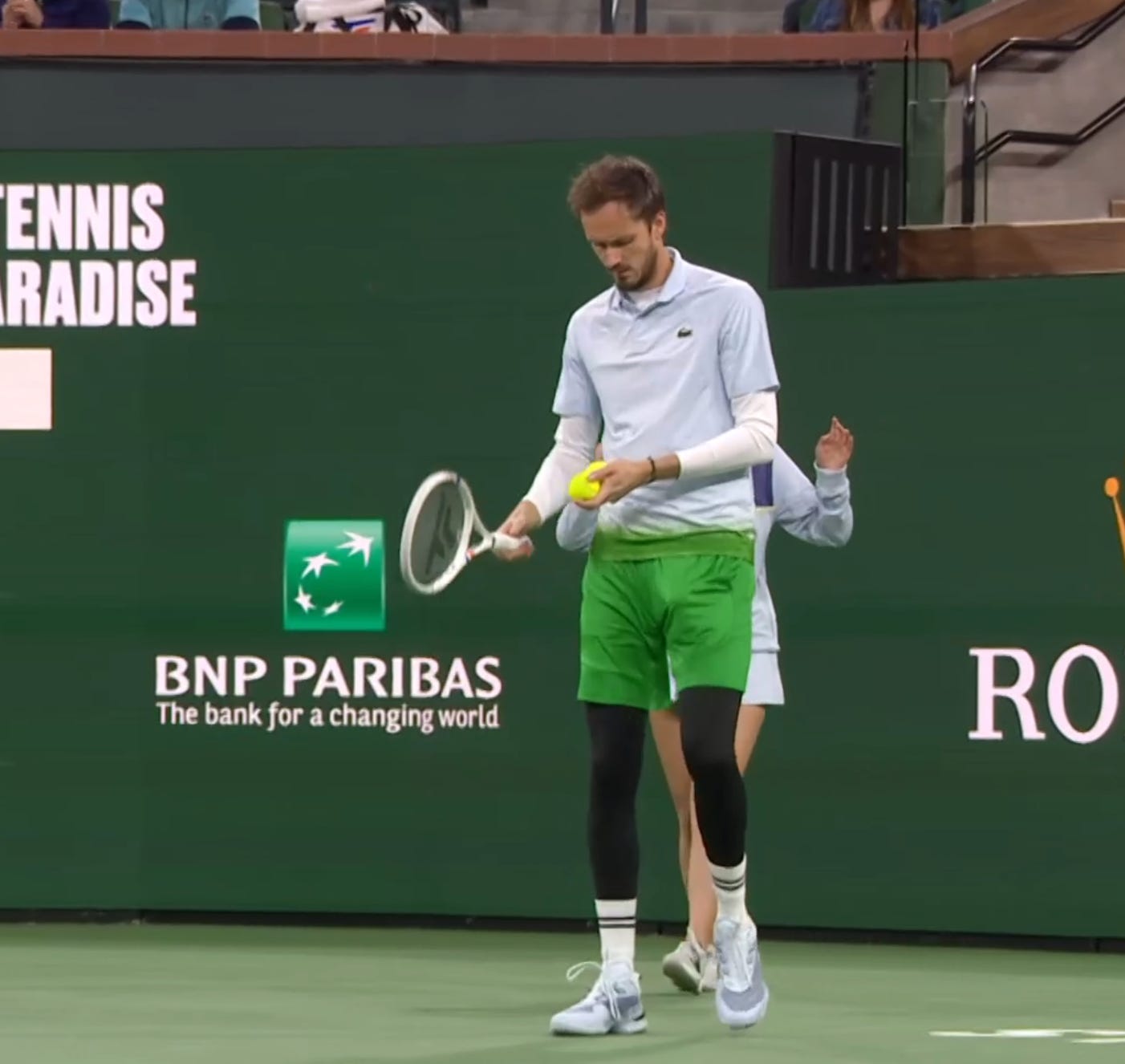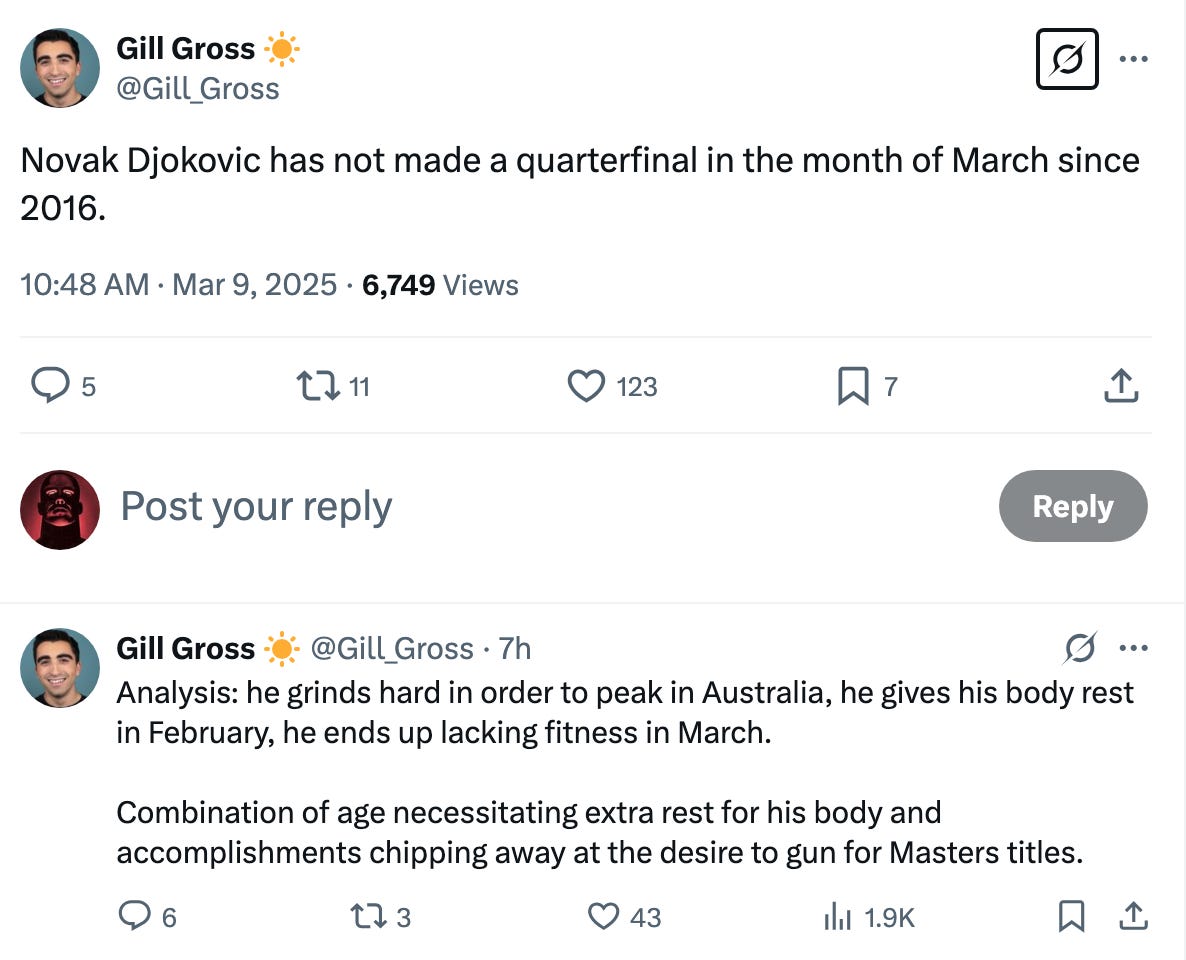Everyone’s played a match. Here’s what I noticed.
Surface update
It’s not that different.
Player quotes from Tennis Majors:
“It’s probably the slowest court I’ve ever played in my life.” — Medvedev
“Honestly, I don’t feel much difference.” — Swiatek
“I think I play great tennis anyway, even though the courts are a bit faster. But all I can say is I didn’t understand when I saw it.” — Alcaraz
“Honestly, I think they might be slower.” — Pegula
I will say that the weather obviously still plays a big factor. Hot days can make it a lot faster and bouncier than some of the very cool evening conditions they had in the opening rounds, and the wind seems to be blowing harder than forecasts suggest.
Med’s evening kit…
Brooksby is back
Brooksby got his first tour level win since 2023, defeating Benjamin Bonzi in three sets in round one. Then he went and knocked out FAA in round two. I thought the American’s backhand down the line was a killer against FAA, who is always hunting for off-forehands. Brooksby’s forehand is also very precise and consistent, and he has that Tien/Djokovic kind of accuracy and change-of-direction element in his game.
Brooksby has always been an unconventional and intelligent counterpuncher, and in that sense he can be a fun player to watch. He was suspended for 18 months for missing three doping tests back in October of 2023, with his sentence later reduced to 10 months. The silver-lining of such an unfortunate incident would have been the ability to work on some of the more technical weaknesses in his game, namely, his underpowered serve. After all, there are no successful small-serve counterpunchers in contemporary men’s tennis.
In this sense, it was a little disappointing to see the American show up with the same motion from 2023. That is a missed opportunity, given the tour wide trend of even little guys beefing up the serve (e.g., de Minaur pushing into the ~210km/h range). We’ve also seen the likes of Sinner and Alcaraz tinker with serve motions during the season and are making gains.
Against FAA, Brooksby’s average first serve speed was ~114mph (183 km/h). More alarmingly, his second serve average was ~87mph (140 kmh). That is pedestrian. For comparison, FAA’s second serve average for the match was ~107 mph (172 km/h).
You can often get a hint of how explosive a server’s kinetic chain was (and therefore, how explosive the serve was) by virtue of their right leg after landing. The back leg kicks up to balance all the forward and rotational momentum that went into the shot. A strong leg kick hints at a strong action.
Watching Brooksby, and then Alcaraz later in the day, provided a stark contrast:




Look how fast Shelton’s back leg kicks and comes through in his 149mph serve from the 2023 US Open:
Serves aside, Brooksby is through to the third round and takes on Draper.
Tsitsipas’ backhand
The Greek kept the Dubai streak rolling with a second-round win over Thiago Seyboth Wild 6/2 6/4. I’m pretty excited for this little unexpected storyline in the season. At a time when Tsitsipas was seemingly on a slow slide into irrelevance, watching the likes of younger stars like Alcaraz and Sinner over take him, the Greek has taken action to reverse course.
With the blacked-out Wilson still in hand, the backhand speeds were up 5 mph compared to last year.
If Stef can make a bad backhand average, or rather, have some meaningful cuts when it matters, that can often be the difference. Here was an early example on break point:
Gill Gross did a data dive with Tom Corrie from Tennis Insights this week (watch here) following Tsitsipas’ Dubai run and discussed the headline-grabbing performance of his backhand. An excerpt:
“The returns, when you look at the numbers, no notable increase in returns in terms of in-percentage, speed, accuracy. Of course he did do some good ones, but the aggregation across the tournament, despite winning the tournament, wasn’t standout better.”
“Everybody was going wild for it [the backhand/return] and saying he’s returning better on socials, but actually, the numbers weren’t backing that up — yet.” — Tom Corrie
This was interesting to me, because I was (still am?) one of those people going wild on socials (Substack).1 I have nothing quantitative to support this position like Tennis Insights, but the eye test and general feeling — the gut feel — has me believing it is better. Better means it’s gone from one of the worst on tour, to something average that he can hide reasonably well with his serve and forehand.
There’s obviously no perfect way to put a number on a shot (like a Tsitsipas backhand score) and I am a huge fan of what Tennis Insights is trying to do with their AI algorithms, but is an aggregation the best method of assessing shot quality?
What I saw in Dubai was still plenty of what I’ll call ‘Stef’ backhands: shanks, missed returns, weak replies. But he undoubtedly was also smoking returns in patches when it mattered. Stringing a couple of returns together in one game is more valuable than making one in each return game.
For example, in the final against FAA, the backhand was pretty bad through the first 6 games or so of the first set. But he caught fire with it when it mattered.
What set up the first break point that he would go on to convert?
The same could be said for the other two games the Greek broke in where the backhand proved instrumental on return.
It’s unclear to me if Tennis Insights applies some sort of weight to return quality (or other shots, for that matter) on important points — 30-30, deuce, AD, break points, tiebreakers — or similarly, if you make a streak of good returns in a row, as Tsitsipas did in the 5-3 game of the first set. It would be an interesting exercise if they did (assuming they don’t).
Tsitsipas takes on Berrettini in round three in what should be a cracking match.
Fonseca vs Draper: seasoned pro defeats raw potential
Jack Draper defeated Joao Fonseca 6/4 6/0 in what was a masterclass in containment. The more physical and experienced Brit used his serve, heavy forehand, and movement, to keep the ball out of Fonseca’s strike zone and weather the aggression. The pair split their forehand winners at 9 each, but Draper only made 6 errors to Fonseca’s 20.
Sidenote: this brings me to another qualitative point about missing: that there is signal in missing. If you miss a well-struck ball by a small margin, the quality of that shot is better than shanking a miss by three metres. It sends a signal to the opponent in a way the shank does not. That can have downstream effects on tactics. There is quality to be measured in misses.
Many of Fonseca’s misses were in this category.2 Struck cleanly, missing by a fraction.
The scoreline is a bit misleading. Fonseca got to 30 in all of Draper’s service games save one, and had break chances in three different games. Draper saved 6/7, Fonseca only managed to save 3/8.
Draper was very disciplined at starving Fonseca’s forehand, using his own high and heavy lefty forehand crosscourt to get the ball up high on the Brazilian’s backhand. Draper’s rally forehand averaged 96cm of net clearance compared to Fonseca’s 68cm, and the Brit went crosscourt (into the Fonseca backhand) 63% of the time. On the backhand, Draper hit more backhands down the line (52%) — again into the Fonseca backhand — than he did crosscourt (48%). Other notable numbers:
On a bouncy Indian Wells court, and with some wind around, the Brit was very good (he reminds of another heavy lefty forehand/flat backhand Brit who won here recently). He’s going to be tough to stop this week, but his match against Brooksby presents a completely different opponent. Expecting some long rallies here.
Djokovic lost to a Lucky Loser for the second year in a row
Last year it was Luca Nardi. This year it is Botic van de Zandschulp.
It’s hard to believe that this kind of early exit during the Sunshine Double has been standard for the last circa decade. A stat:
It was interesting to hear Murray send out some technical advice during the match following a missed forehand return from the Serb:
I’ve said from the start of the year that Djokovic cares about two titles: Australian Open and Wimbledon. I don’t think he has a chance in best-of-five clay at his age, and with Alcaraz and Sinner back in the mix there. Wimbledon is the best bet and Murray would be great on the bag.
Some great matches coming up tomorrow, but I'm most looking forward to:
Paul vs Norrie
Tsitsipas vs Berrettini
Rune vs Humbert
Fils vs Musetti
See you in the comments. HC
I did also note that Stef is still a serve +1 forehand kind of guy. That’s important to remember. The backhand has improved in my eyes, but it’s improved from very bad, to okay.
Admittedly he does let some high forehands approach the gulf stream.











Will never understand how Brooksby was allowed to develop as a junior all the way to Baylor without addressing that serve motion. I mean, he's 6'4".
Regarding Brooksby's serve, maybe they couldn't work on it because of his wrist surgery. Or are scared to touch it now until he gets back to a safer ranking... Getting into a player's serve demands some cold nerves from a coach! Yet when you see how Nadal and Djokovic worked on that shot through the years, you know it's rewarding.